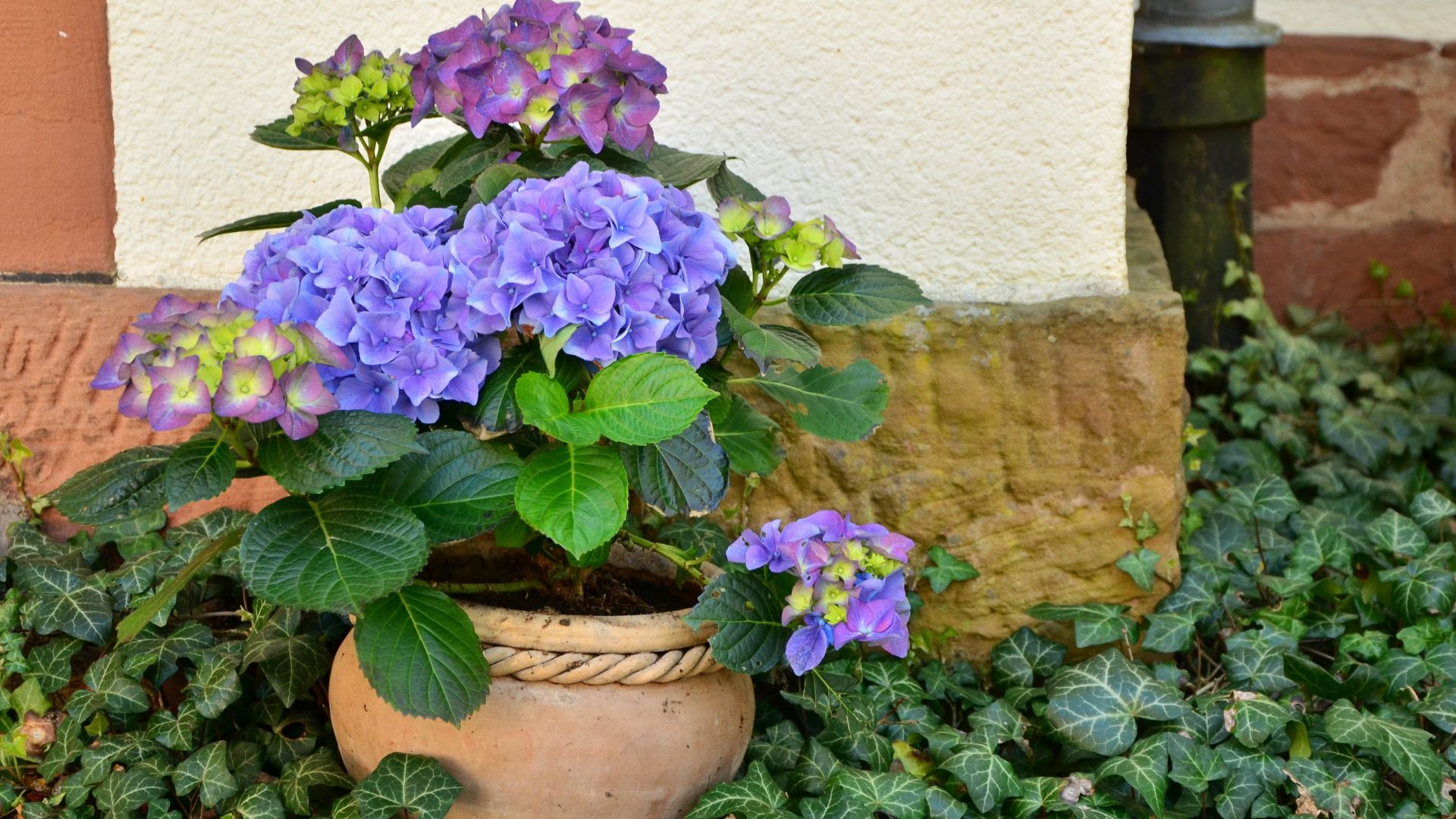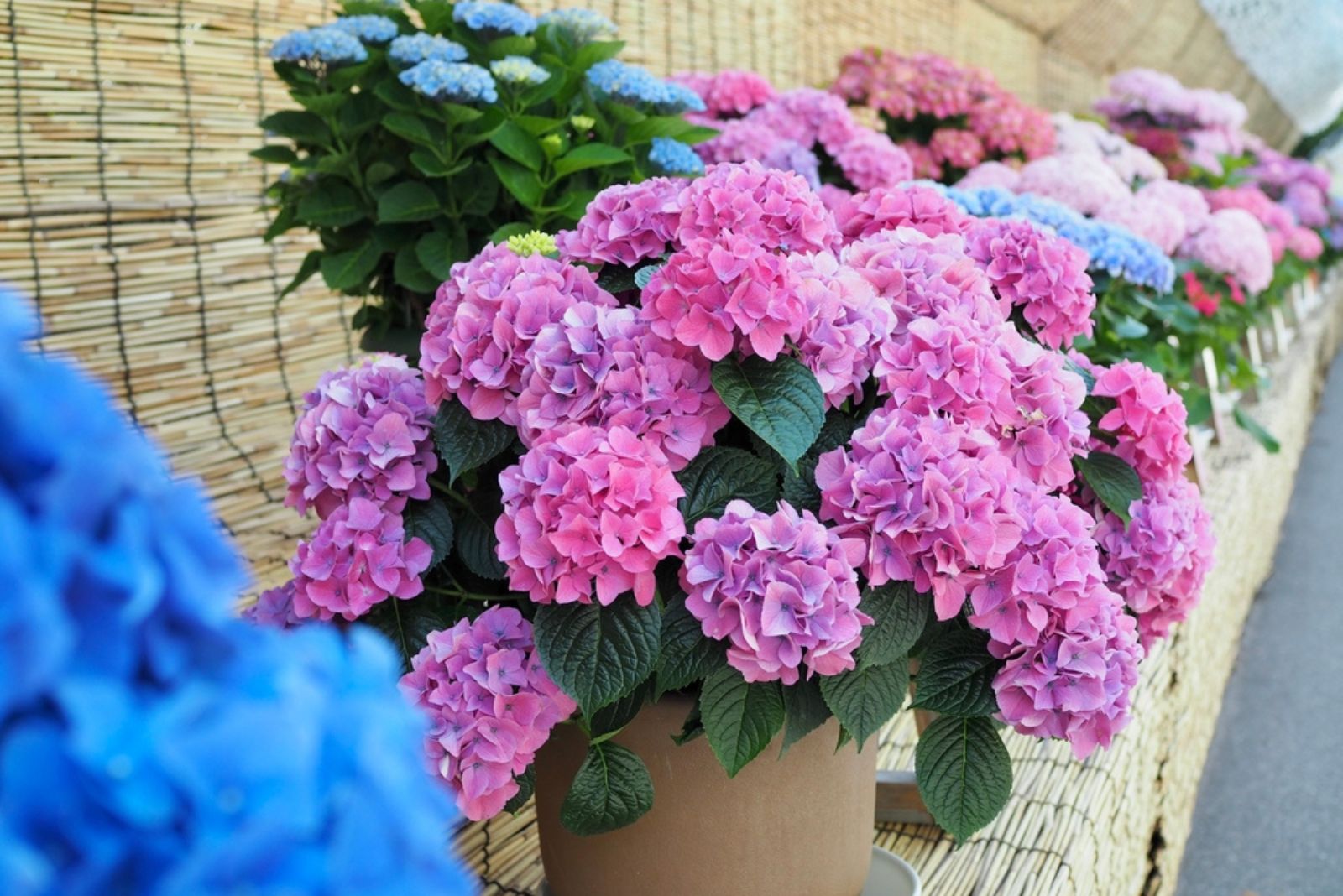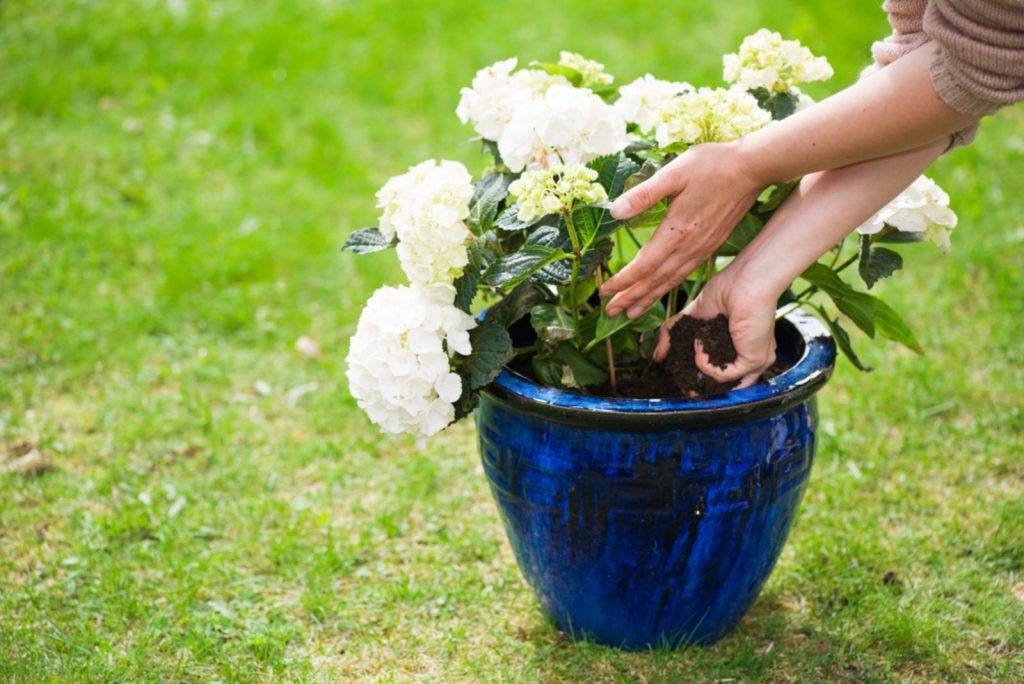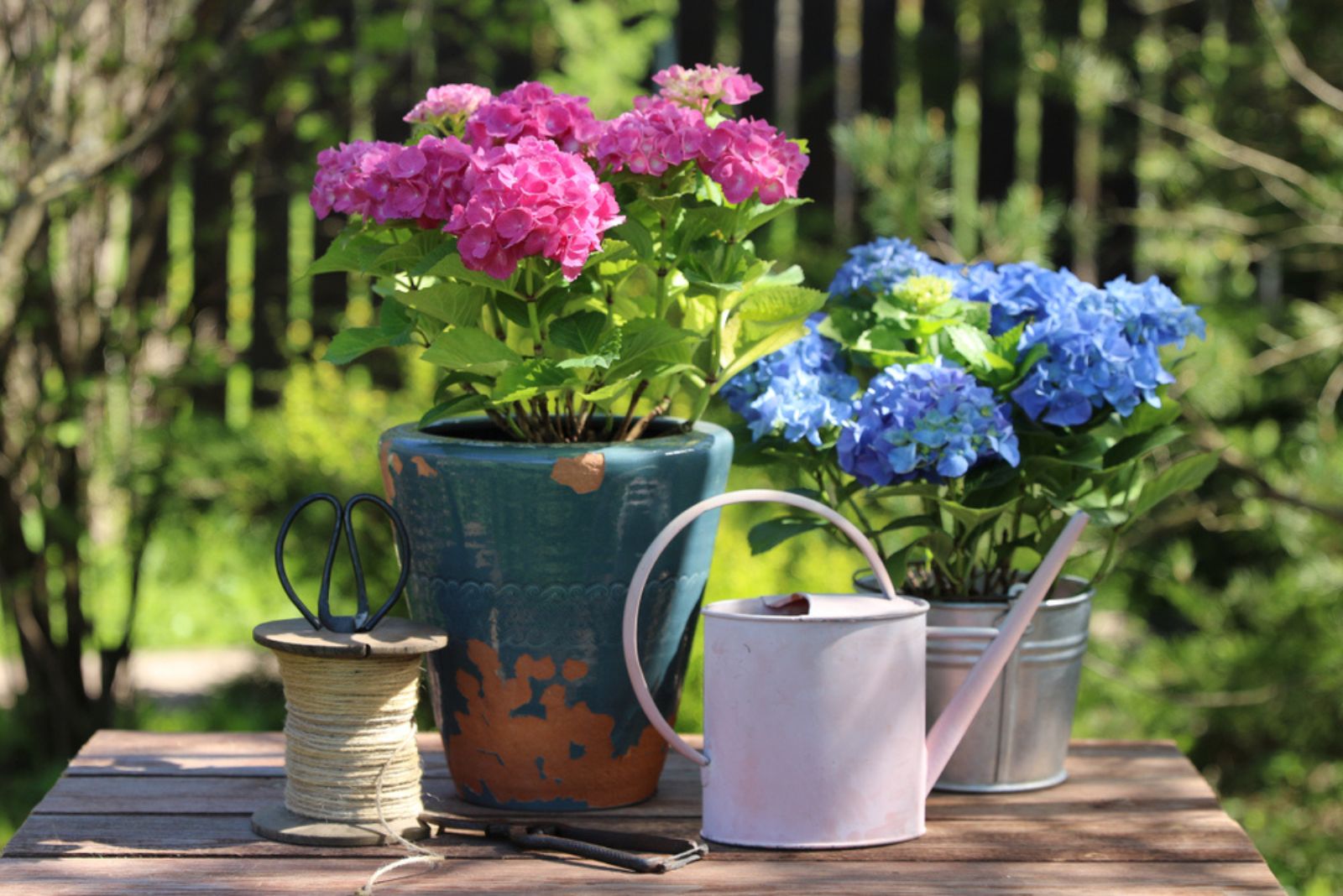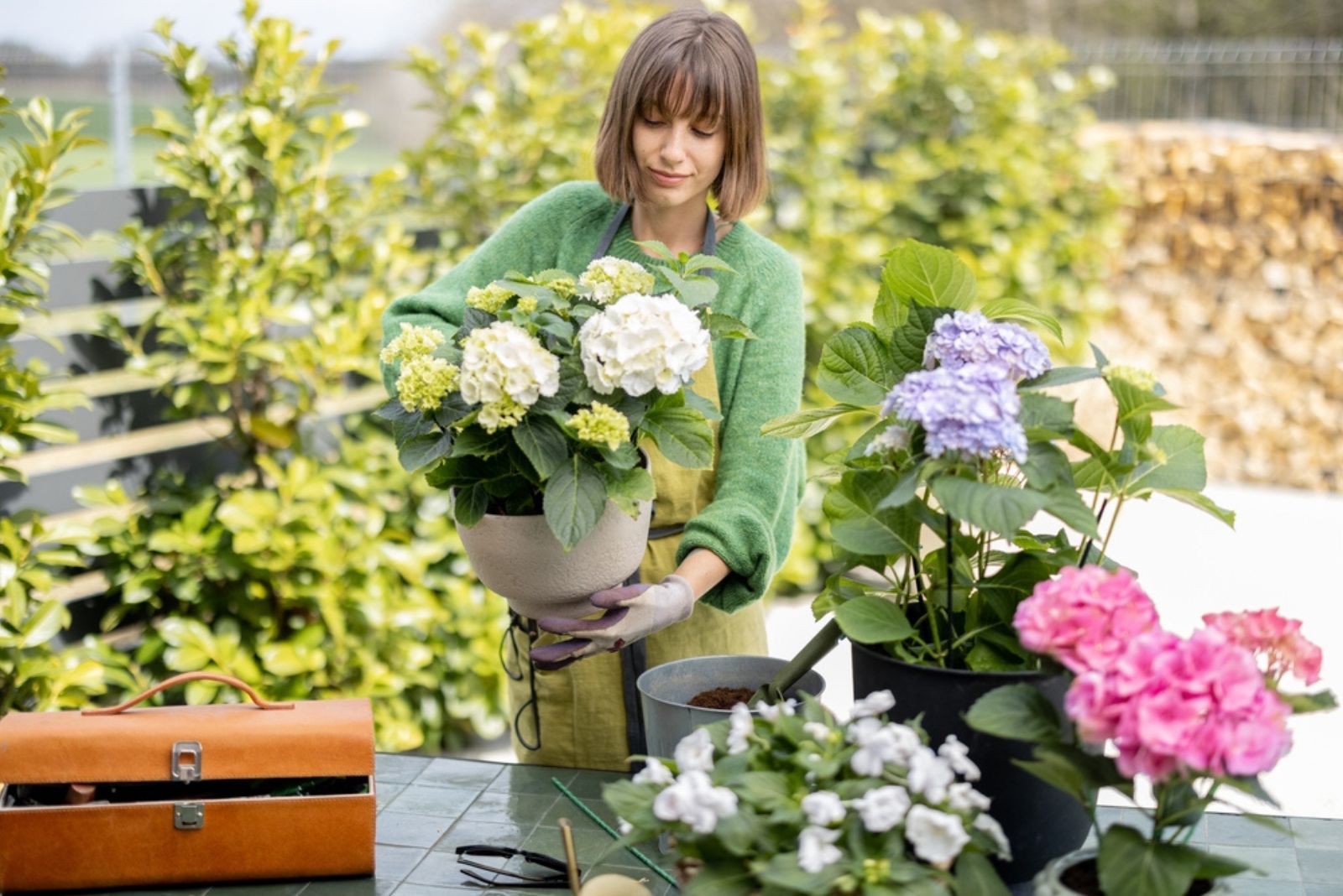I know we’re all used to seeing hydrangeas in the ground. And don’t get me wrong, they look stunning in flower beds.
But did you know that you can take this beauty and move it onto your porch or even indoors?
Yes, you can grow hydrangeas in pots and it’s easier than you’d think.
Let’s dive in!
Can You Grow Hydrangea In A Pot?
You can easily have thriving hydrangeas in pots as long as you care for them properly. And the first step is to decide how long you want to keep them in containers.
If you want hydrangeas in pots for only one season, you have numerous options when it comes to choosing the plant variety or the planter.
But if you want a container to be your hydrangeas permanent habitat, you’ll need to choose the variety and the pot more carefully.
Choosing The Best Varieties
There are various types of hydrangeas out there, but if you want to keep them in containers, opt for shorter and more compact options. Bigleaf, mountain, smooth, and panicle hydrangeas are perfect, especially if you go for shorter cultivars.
Bigleaf hydrangea (H. macrophylla) – ‘Pop Star,’ ‘Paraplu,’ ‘Paris Rapa,’ ‘Mini Penny,’ ‘Monrey’
Panicle hydrangea (H. paniculata) – ‘Candle Light,’ ‘Little Quick Fire,’ ‘Bombshell,’ ‘Fire Light’
Mountain hydrangea (H. serrata) – ‘Euphoria Pink,’ ‘Tiny Tuff Stuff,’ ‘Bluebird’
Smooth hydrangea (H. arborescens) – ‘Annabelle,’ ‘Strong Annabelle, ‘Candybelle Bubblegum’
Note: It will be easier to overwinter your hydrangeas in pots if you look for hardy varieties, especially those that can handle hardier zones than your own.
Selecting A Suitable Planter
When choosing a suitable container for your hydrangeas, look for ones 18-24 inches deep and wide. These can fit the root system well and won’t cram your plants.
Also make sure the pot has a drainage hole so the moisture can leave the planter and not accumulate at the bottom and risk root rot.
Ceramic, clay, and terracotta pots are perfect for warmer climates, but these same planters can break when the soil freezes in colder regions. You can use plastic ones, just know that they dry out a little slower than clay ones.
Finally, it would be a great idea to pot your hydrangeas in the location you intend to grow them. Large pots filled with soil are difficult to move around – although, you can always get planters with wheels.
Finding The Right Location
The perfect spot for hydrangeas is one that gets indirect or dappled sunlight during the day, whether you plan on keeping it in a planter for one or more seasons.
If you have a brighter location in mind, you can try growing panicle hydrangea cultivars because they can tolerate sunlight a bit better as long as you keep them moist.
But bear in mind that hydrangeas prefer some shade during the hottest part of the day, so try to find a spot that meets those preferences.
Also, place it in a location where it will be protected from harsh winds and drafts; their large foliage can lose plenty of water on windy days.
How To Plant Hydrangeas In A Container
When planting hydrangeas in a container, go for a high-quality, well-draining potting mix. You can choose one that already has plant food in it or add some worm castings to feed your plant during the first season.
If the root ball is all intertwined, you can loosen it up a bit. Just don’t tug the roots too much since that can stress the plant and break the roots.
Place some growing medium in the bottom of the container and put your hydrangea in it. Backfill the planter with more soil and pat it down gently to get rid of air pockets.
Make sure the plant is straight and that it is at the same depth it was in the previous container.
Water your plant slowly until you notice that the water has started to come out of the drainage holes. Let it rest for an hour, and if the soil level lowers, add a bit more, and water again.
Don’t worry about overwatering it! These are thirsty plants that like moisture.
In the end, add a layer of organic mulch such as wood chips to help the potting mix retain moisture and keep the roots cool in the summer.
Pro tip: Did you know that you can change a hydrangea’s color based on the pH level of the soil? Choose a suitable variety and experiment with blue, pink, purple, and red!
Water Requirements
Hydrangeas are thirsty plants and those grown in pots can dry out pretty quickly. If your plant doesn’t get enough moisture, it will wilt and droop. In return, this makes the hydrangea weaker and more susceptible to pest infestations and infections.
Monitor your plant and check the moisture every 1-2 days. If it’s hot, check your hydrangea daily and water it whenever the top few inches of the pot feel dry.
As your plant begins to grow and its root system takes up more space in the planter, you might need to irrigate it more frequently.
Just remember to water it at the base without wetting the leaves since that can lead to fungal diseases such as powdery mildew.
And lastly, don’t let your hydrangea sit in water all day long. This will lead to root rot and may kill your plant. Instead, get a container with drainage holes and place a saucer underneath.
You can also place the first pot into a larger, decorative one, just make sure to put gravel or pebbles in it to keep your plant above water level.
Fertilizing Potted Hydrangeas
Fertilizing hydrangeas can make their blossoms much more beautiful, so it’s a great idea to add fertilizer every once in a while.
However, you don’t need to apply plant food immediately after repotting or transplanting. That’s because commercial potting mixes usually contain plant food that can keep your hydrangea flourishing throughout the first season.
You can begin the next season by applying a fertilizer specifically designed for acid-loving plants such as azaleas, rhododendrons, and hydrangeas.
Choose a fast or slow-release fertilizer and apply it according to the instructions on the package.
And if you want to improve the quality and quantity of blossoms, apply the fertilizer as the buds begin to set (from midsummer until fall). Just remember to take them indoors because the new growth is tender and can’t survive the harsh winter temperatures.
Overwinter Tips
If you live in a warm climate, your potted hydrangea will do just fine when placed outside all year long. Just make sure to reduce the watering slightly as the temperatures go down to avoid overwatering.
In colder regions, water your plants deeply, mulch them, and protect them from harsh winds and freezing temperatures.
Potted hydrangeas are even more sensitive to temperature changes since pots aren’t as isolated as the in-ground soil is.
It is best to leave your hydrangeas outdoors, if possible, to adjust to the seasonal changes, but you should take them inside if your region experiences extreme cold.
If you don’t need to bring the plant indoors, you can place it near some protective walls such as on a patio, near a garage, or a shed and protect it from the wind that way. Just make sure it is in a location where it can get enough sunlight and precipitation.
You can also cover your hydrangea with a freeze cloth to mitigate the effect cold might have on it.
Repotting
Growing hydrangeas in a tight spot, such as containers, means you’ll have to repot them eventually.
Once the hydrangea becomes pot bound, its growth will slow down and it will produce fewer blossoms.
The roots fill the entire pot and there’s not many nutrients left in the potting mix.
Once this happens, you have to take your plant out of that container and move it to a larger one filled with fresh growing medium.
Choose a container 1-2 sizes larger than the previous one to ensure enough space for the roots and avoid waterlogging.
Goodbye Tips
Here are a couple more tips and things you need to know about growing potted hydrangeas.
Growing Hydrangeas Indoors
Technically, you can grow potted hydrangeas indoors but they will start to diminish within a few months and lose some of their allure. These plants need exposure to weather changes, so make sure to keep them outside most of the year.
How Long Hydrangeas Can Last In Pots
If you take good care of them, hydrangeas may last for more than 50 years. You will have to repot them every 3-5 years, but that’s a small price to pay for such beauty.
Growing Other Plants With Potted Hydrangeas
You can grow various plants with hydrangeas in the same pot, especially during the first couple of years when this shrub is still small and there’s plenty of room in the planter.
Some of the most famous hydrangea companion plants you can add to containers include speedwells (Veronica), Swedish ivy, coral bells, etc. Add some trailing petunias and lobelias for a spilling delight and a splash of color.

